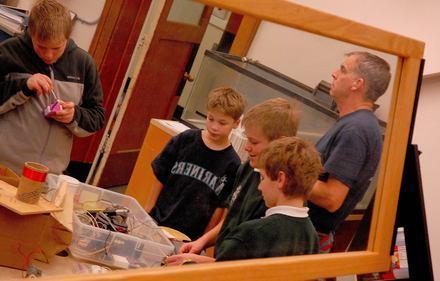New St. Alphonsus science lab is "cool"
HANDS-ON IN NEW LAB. Science teacher John Anderson helps Wyatt Degagne and others build crystal radios in his after-school science club in the new science lab at S. Alphonsus Parish School in Ballard.<br><br>
Mon, 01/05/2009
Electricity is in the air at St. Alphonsus School in Ballard thanks to its new science lab.
The school received a $127,000 grant from the E. L. Wieglund Foundation in Reno, and an additional $35,000 raised at its Fund-A-Dream auction, to pay for the updates. The original lab was designed in 1923, a mere 44 years after Edison invented the light bulb, and updated in the 1950s. It now boasts two trifacial sink islands equipped with gas and electric outlets, a moveable science cart with mirror, fire-resistant tables, brighter lights, a ceiling mounted computerized projector, new microscopes, and Full Option Science Systems, or "FOSS" kits for the kindergarten to forth grade students. Kits facilitate the study of solar power, food and nutrition, magnetism, and plants.
"I'm totally impressed, both with the lab and the curriculum," said Maureen Reid, this year's interim principal. Reid, St. Matthew's former principal, taught science for 17 years at Seattle Prep High School.
"The lab is hands-on to engage students. Kids love science. I see kids using the (new) microscopes and doing demonstrations. Many think Catholic schools don't do a good job in science and math instruction. This lab is a visible symbol of the commitment this community has toward math and science education. This is a top of the line science lab."
"I teach four classes in the lab a day," said John Anderson, who is a big hit with his students.
"It's a lot of fun in here," he grinned, obviously pleased with his new classroom. "It's a lot brighter, more room to move, and kids genuinely enjoy it. My supplies are very accessible and there is good storage. I can crank up my computer on the overhead projector, which really helped while we built a DNA model."
Anderson recalled that the old lab had extension cords snaking away from the teacher's desk, one burner by the desk, and he sometimes had to leave the room to retrieve supplies during class.
Anderson conducts the after-school science club in the new lab as he has for the past five years. The students have paired up to build crystal radio sets, assembling the coil, tuning capacitor, and diode, while using the energy of radio waves for power, and old telephone receivers as head phones. A grounding wire is dangled out the window.
"We're near some AM stations, so we should pick up AM channels," Anderson said with optimism.
"I did science club last year as well," said Joe Chamberlin, 11. "It's fun building things. Once we built motors out of dry ice we put in water. This year's class is a lot better with the new lab, more storage space with cabinets, sinks, the movable science cart with mirrors that turn around."
This is the first year at the science club for twins Wyatt and Lucas Degagne, 7th graders.
"We get to do more things than in regular science class," said Lucas.
"It's pretty cool, and new," added Wyatt, impressed. "We use iodine, acid, and other chemicals for experiments. I like using my hands and electronics, so that's why I joined."


